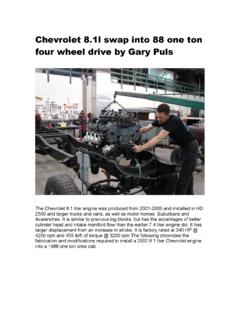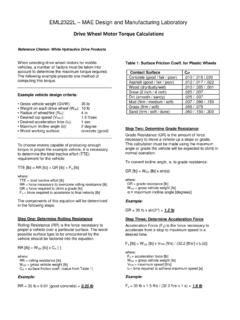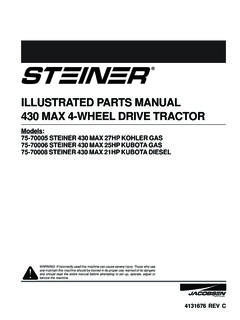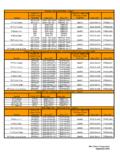Transcription of Types of Toyota 4-Wheel Drive Systems
1 RAV4 Highlander type On-Demand 4WD. Function: The function is simple: 4 wheel Drive when necessary and in the amount needed. initiated, provide driver input by using the dash mounted switch. fuel economy. RAV4 is a front wheel Drive vehicle until/unless 4 wheel Drive is needed. What makes this system operate? An on-demand type system as used in the Matrix utilized a viscous coupling to provide 4WD when needed. The all new 2006 RAV 4 system eliminates the use of a viscous coupling and replaces it with a much faster acting system that produces less drag. MATRIX type. In a 2006 Matrix, a viscous coupling was a part of the trans axle (not available for 2007). In the RAV4, the electric coupling is a part of the rear differential housing and gear set. What input does a driver have? The driver can engage the system by pressing the 4X4 button on the dash. When engaged, a light in the combination meter lights up, indicating the system is in maximum 4WD. This is a split of 55% front Drive and 45% rear Drive .
2 It is disconnected at speed above 25 MPH or by use of braking. It also Interfaces with Electric Power Steering and VSC. Highlander Hybrid type On-demand Adds separate electric generator Drive sys-tem with no driveshaft to rear wheels. Operates the same as RAV4 but is activated by VSC/TRAC system instead of dash mounted switch. Benefit: Saves fuel, provides 4WD when needed, fully automatic or engaged by a driver, works with EPS and VSC. Part-Time 4WD System Tacoma, Tundra and FJCruiser auto-matic Vehicle is mostly operated in 2WD mode directing the power to the rear wheels. When driver manually selects 4WD mode power is directed to all 4 wheels. This type of system typically consists of front and rear differentials with a center transfer case (no center differential) On-the-fly shifting Toyota 's part time 4wd system can be en-gaged at the flick of a shifter or turn of a knob below highway speeds (up to 50mph on Tacoma, 2006 Tundra and FJCruiser and up to 62mph on 2007 Tundra.)
3 There is no need to stop the vehicle to engage the 4wd system. Benefits The benefits of a part time system is the ability to switch from2wd to 4wd. Tundra, Tacoma and FJCruiser automatic are extremely versatile because they are able to use both 2 and 4 wheel Drive modes when needed providing excellent on road in 2wd mode and outstanding off-road capa-bilities in 4wd. Additional Benefits 2wd mode saves fuel and wear and tear on the drivetrain with 4wd mode providing additional traction when needed. Drivetrain Binding on Dry Pavement The way a part-time 4wd system is de-signed both front and rear axles rotate at the same speed when 4wd mode is en-gaged. This splits power at 50% front and 50% rear. On dry pavement this will cause the drivetrain to bind when vehicle is at-tempting any type of turn. Drivetrain bind-ing causes severe strain on various 4wd Drive components. Therefore 4wd mode on these vehicles should only be engaged in slippery conditions such as off road driving and poor road conditions.
4 4LO speed Only to be used in very poor traction condi-tions and at very low speeds Types of Toyota 4-Wheel Drive Systems There are two basic Types of 4wheel Drive Systems : Part Time 4 wheel Drive Designed to be operated in 4WD mode in off-road or slippery conditions ONLY therefore the name Part-Time. Part-Time 4WD vehicles are: FJCruiser (automatic), Tundra and Tacoma Full Time 4 wheel Drive (3 Types ) Full-time 4WD vehicles can be operated in 4WD mode on all driving surfaces Full-Time 4WD vehicles are: Landcruiser, FJCruiser (manual), Sequoia, 4 Runner, Sienna, Highlander and RAV4 Variations of Full-Time 4WD system are Full-Time (always on) for Landcruiser, FJCruiser manual and 4 Runner V8, Full-Time Multi- mode (switch on or off) for 4runner V6 and Sequoia, Full-Time 4WD for Sienna and Highlander and Full-Time On-Demand for RAV4 and Highlander Hybrid FULL-TIME 4WD Systems (3 Types ) Full-Time Multi-Mode Sequoia and 4 Runner V6 This system operates in full-time 4wd mode, but also allows user to select 2wd mode when additional traction of 4wd isn t needed.
5 The 2wd mode provides better gas mileage and reduced compo-nent wear. Center Differential is the reason why this system can be driven on dry pave-ment in 4wd. Center differential allows power to transfer from front to rear of vehicle as necessary for better traction control and prevents drivetrain binding on dry pavement. This is the feature Part time 4WD Systems lack. Full-Time 4WD System FJCruiser manual, 4 Runner V8 and Landcruiser. This system directs power to all 4 wheels at all times. Full-time 4wd vehi-cles can be operated on dry pavement at any time as well as slippery unlike part-time 4wd Systems . This is due to a center differential (torsion) installed on these vehicles. Full-Time 4WD/AWD All wheel Drive Sienna and Highlander gas System This Systems sends variable power to both axles. It incorporates the front differential, center differential and trans-fer case into one compact unit. Rear differential is located at rear axle. Operation AWD system relies on a specialized Elec-tronic Control Unit (ECU) to control wheel spin by applying the brakes to that wheel therefore directing power to other wheels with traction.
6 Benefits This is a light duty system that allows a vehicle exceptional traction at all times while utilizing all the features of VSC and TRAC.






